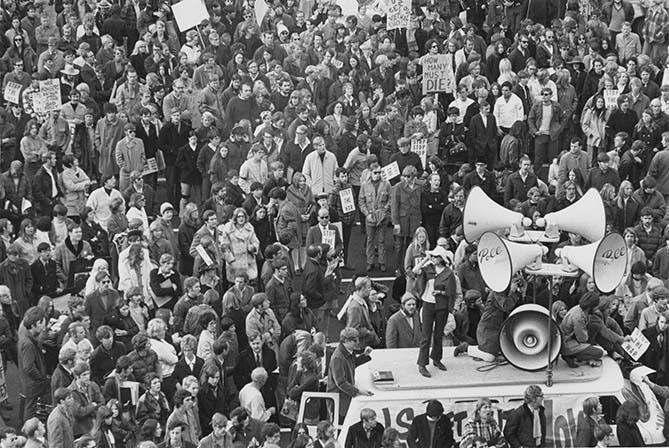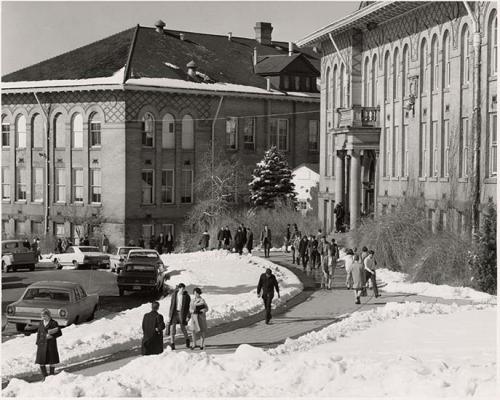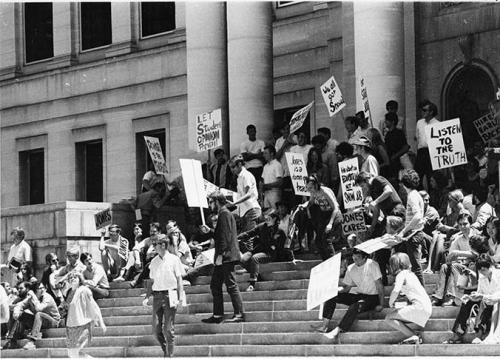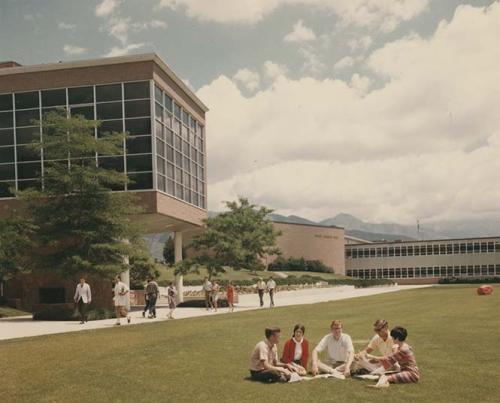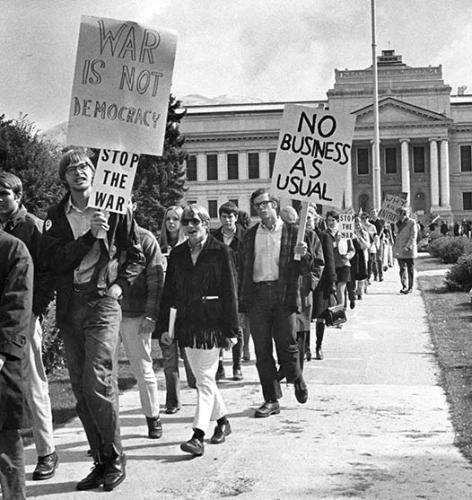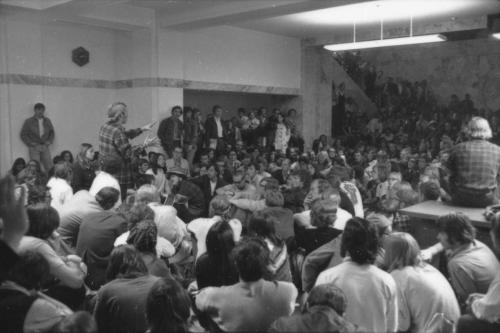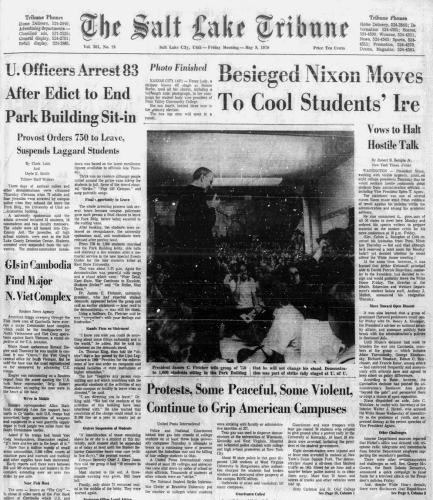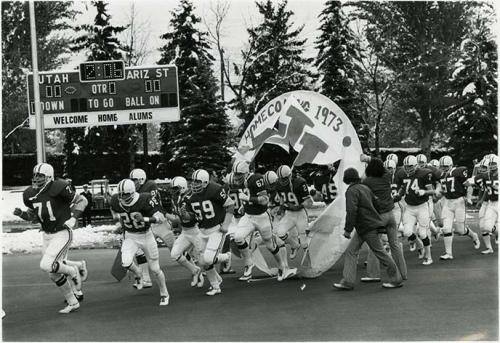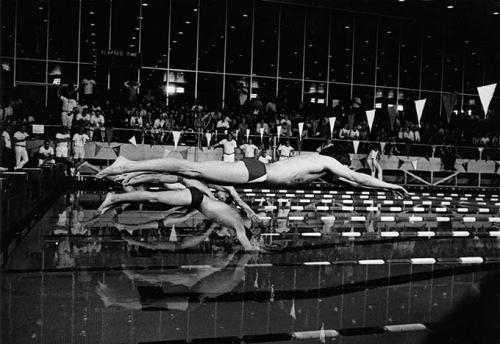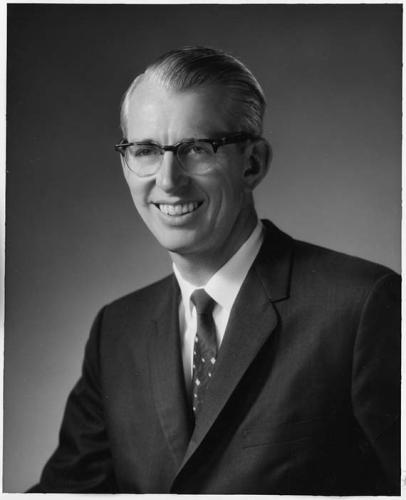A Time of Tensions, 1964-1973
In 1964, James C. Fletcher was inaugurated as the eighth president of the University of Utah. Even before he took office, the school had embarked on a massive building program that would change the shape of the campus forever. By 1967, there were over $61 million worth of building projects underway, including the Marriott Library, the Mines Building, the Social and Behavioral Sciences Building, the Nursing building, the Pioneer Memorial Theater, the campus bookstore, the College of Law Building, and the Special Events Center. Remodeling was taking place in Orson Spencer Hall, the Medical Student Housing towers, and other older buildings. In addition, there were major landscaping projects on campus and many roads were being either torn up or improved. No wonder so many students and faculty complained that the University of Utah campus consisted of “dirt, rocks, and mud.”
As the campus once again underwent physical transformation and enrollment grew rapidly as the first waves of the “Baby Boomer” generation entered college, national and international political tensions manifested on campus in numerous ways. In 1966, the university created its own police force in response to student unrest and the increased presence of the Salt Lake City police on campus. In contrast to previous decades, anti-war sentiments became common among students, leading to heated debates in the Daily Chronicle about ROTC and the role of military training on campus. By the late 1960s, protests against the Vietnam War were beginning to take place on campuses all across the nation, and the University of Utah was no exception. A branch of the activist organization Students for a Democratic Society was organized in 1968 and immediately began organizing demonstrations. In October 1969, several thousand students paraded from campus to the Federal Building in downtown Salt Lake City to protest the war.
These activities were nothing compared to what happened after the invasion of Cambodia in the spring of 1970. After the deaths of four students at Kent State University in Ohio on May 4, 1970, students rioted across the country, including at the University of Utah; classes were disrupted, the Daily Utah Chronicle offices were occupied, and the ROTC building was fire-bombed. On May 6, four thousand students gathered for a rally south of the Union Building. During the rally, fire broke out in an abandoned World War II building near the Union. The building was no great loss, considering it saved the costs of razing it, but a short while later, 800 students marched into the Park Building and sat down. Although most left when they were told they would be suspended from school, others stayed and were arrested later that day. Finally, the National Guard headquarters building just south of campus was bombed early the next morning. All these events left a lasting impression: to this day, campus legend holds that the hilly landscaping around the Union building was put in place to deny rioting students a place to assemble, and that the sidewalks on campus were purposely made wide enough to accommodate an army truck.
In addition to activism in response to national and international issues, students also responded to campus controversies and changes through protest. Students protested tuition increases, the establishment of a parking system, and the lack of married student housing. After the first women’s dormitory, Carlson Hall, was reassigned to the Quinney Law School in 1971, campus legend states that, as the Administrative Vice President, the Dean of the Law School, and the architects met in the dining room of Carlson Hall to finalize the plans, suddenly the door opened and in marched a silent procession of women, dressed in flowing robes, with lighted candles. The last two women in the ghostly procession carried a portrait of Mrs. Carlson, draped in black.
Despite the tumult and tensions, life at the University of Utah went on for the majority of students, faculty, and staff. The football team went to the Liberty Bowl in 1964 and defeated the University of West Virginia 34-6. In 1966, the Ute basketball team won the Western Athletic Conference title, while the men's wrestling team took home the title in 1969. The Utah men's swim team dominated the WAC for most of the decade, winning eight conference championships. Notable celebrities such as singers Harry Belafonte and Ella Fitzgerald came to perform at the University of Utah. Avant-garde artist Andy Warhol, though scheduled to speak himself, seemingly sent a double to speak in his stead, setting off a storm of controversy and speculation. Other speakers reflected the turbulent times: civil rights leaders Dick Gregory and Julian Bond; political candidates Ted Kennedy and Hubert Humphrey; activists such as Timothy Leary, Jerry Rubin, and Alan Ginsberg all appeared in venues at the University of Utah during the 1960s.
With the growth in student population and the wave of new construction came a corresponding increase in faculty, departments, and student resource centers. In 1964, history professors A.R. Mortensen and C. Gregory Crampton founded the Western History Center, later the American West Center, dedicated to producing research and primary sources about the western United States, particularly through the creation of oral histories. In 1965, politician and businessman Robert H. Hinckley founded the Hinckley Institute of Politics on campus, a nonpartisan institution dedicated to educating and assisting students in entering politics through lectureships, scholarships, and internships. In1967, the Department of Architecture became the Graduate School of Architecture. In 1965, the University of Utah recruited David C. Evans from the University of California, Berkeley with the charge that he establish a computer science department. Evans soon obtained a large grant from the Advanced Research Projects Agency Information Processing Techniques Office (ARPA ITO) to establish a center for computer graphics excellence, a mandate he immediately pursued through the recruitment of Ivan Sutherland. The University of Utah became the location of one of four original ARPANET nodes, linking to Stanford Research Institute in 1969.
By the time the turbulent 1960s transitioned into the comparatively stable 1970s, the University of Utah had begun to gain international recognition as a center for research. In the coming decade, the work that President Fletcher had begun in fostering new technologies at the University of Utah would flourish,attracting innovative professors and training new generations of students in fields that would affect the lives of people far outside the campus on the hill.

